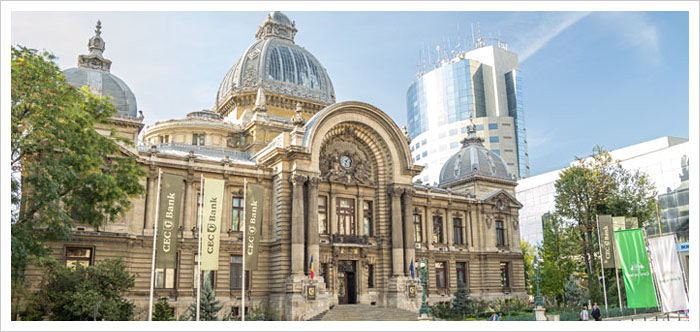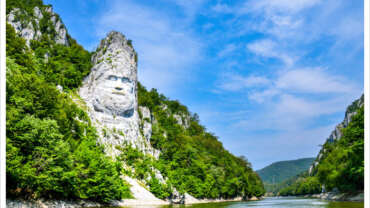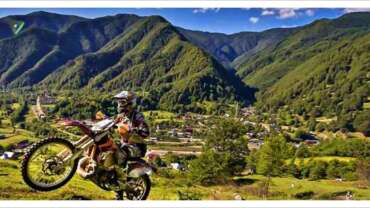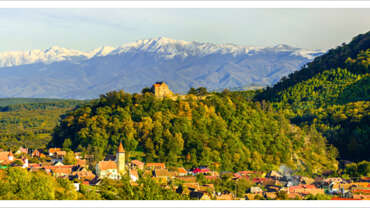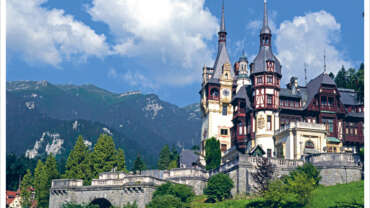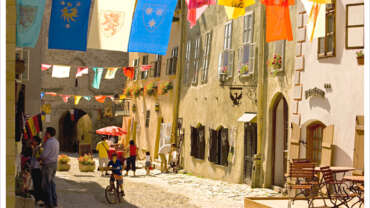Main Cities of Romania
Bucharest – Known for its wide, tree-lined boulevards, glorious Belle Époque buildings and a reputation for the high life (which in the 1900s earned its nickname of “Little Paris”), Bucharest, Romania’s largest city and capital, is today a bustling metropolis.
Romanian legend has it that the city of Bucharest was founded on the banks of the Dambovita River by a shepherd named Bucur, whose name literarily means “joy.” His flute playing reportedly dazzled the people and his hearty wine from nearby vineyards endeared him to the local traders, who gave his name to the place.
Alba Iulia – The gentle climate and the richness of the soil made the area around Alba Iulia inhabitable since ancient times and established Alba as a leading wine growing region since 1st century AD. Northwest of Alba Iulia are the Apuseni Mountains and in the east the Transylvanian Plateau with its rolling hills and deep, wide valleys.
One of the oldest settlements in Romania, known in ancient time as Apulum, Alba Iulia served as the largest military and economic center during the Roman occupation. Temples, mosaics, thermae and statues, amphitheaters, the governor’s palace “Daciarum Trium” – all rendered the original Dacian Apulul as the miniature copy of the mother Rome.
An Episcopal citadel and an important political, military and cultural center, Alba Iulia reached its peak between 1542-1690, serving as the capital of the independent Principality of Transylvania and the residence of the Transylvanian princes. In 1599, Mihai Viteazul (Michael the Brave) achieved here for a brief period of time the union of the three main provinces of Romania: Walachia, Transylvania, and Moldavia. The town later became an important printing centre. Nowadays the local universities continue the tradition of the old academic schools.
The peasant revolt led by Horea, Closca and Crisan, executed on February 28, 1785 on the Pitchfork Hill (Dealul Furcii) turned the city into a symbol of the fight for justice and freedom.
It was here that on December 1st 1918 the province of Transylvania announced its unification with Romania. In 1922 Prince Ferdinand was crowned King of Romania in an act which mirrored the union achieved more than four centuries earlier by Mihai Viteazul.
In the old town visitors can stroll along the wide, tree-lined streets of the Habsburg citadel, one of the most impressive in Europe, to discover the historical, cultural and architectural places of interest of Alba Iulia: the Roman Catholic Cathedral – the oldest and most valuable monument of architecture in Transylvania., the Batthyaneum Library, the Orthodox Cathedral of the Reunification, the Babilon Building – housing the National Museum of Unification, the Union Hall, the Apor Palace, the Princely Palace, and the University of Alba Iulia.
Arad – Straddling the Mures River and occupying parts of both Crisana province and Banat, Arad traces its history back to the 11th century. Arad developed as a major trading post during the Turkish occupation, between 1551 and 1699. After 1699, the city was ruled by the Habsburg Monarchy and in 1834 Arad was declared a ‘free royal town’ by Emperor Francis I of Austria.
Today, Arad is an important industrial center and transportation hub, as well as home to two universities, a Romanian Orthodox theological seminary, a training school for teachers, and a music conservatory. Churches and cathedrals in the city span four centuries, several denominations, and architectural styles ranging from baroque to neoclassic.
Arad County is also home to some important Orthodox monasteries, such as the ones from Hodos-Bodrog (dating from 1177), Bezdin (dating from 1334), Gai (built in 1760-1762), the Sf. Maria – Radna Franciscan Monastery (built in 1727 – 1826), the Princely Orthodox Church from Halmagiu (dating back to the 14th century), the Roman-Catholic Church from Sânpetru German (built in 1774).
Baia Mare (By ah Mah reh) – One of the most important mining centers of Romania, Baia Mare has a history of more than 2,000 years of gold, silver, and other nonferrous metals extraction. First mentioned in 1329, Baia Mare has preserved some its medieval past around the main town square, Piata Libertatii.
The oldest house here, dating from the 1440s, stands on the east side of the square, a lone remnant of a long-gone castle built by Transylvanian prince Iancu de Hunedoara for his wife Elisabeta. The house, appropriately named Casa Elisabeta, is now an art exhibitions venue.
Towering above the square is the Gothic-style 120-foot-tall watchtower, Stephen’s Tower (Turnul lui Stefan), spanning six centuries of history.
BRASOV [Bra’ shov] – Fringed by the peaks of the Southern Carpathian Mountains and resplendent with gothic, baroque and renaissance architecture, as well as a wealth of historical attractions, Brasov is one of the most visited places in Romania.
Founded by the Teutonic Knights in 1211 on an ancient Dacian site and settled by the Saxons as one of the seven walled citadels*, Brasov exudes a distinct medieval ambiance and has been used as backdrop in many recent period films.
The location of the city at the intersection of trade routes linking the Ottoman Empire and western Europe, together with certain tax exemptions, allowed Saxon merchants to obtain considerable wealth and exert a strong political influence in the region. This was reflected in the city’s German name, Kronstadt, as well as in its Latin name, Corona, meaning Crown City (hence, the coat of arms of the city which is a crown with oak roots). Fortifications were erected around the city and continually expanded, with several towers maintained by different craft guilds, according to medieval custom.
Stroll around the old Town Hall Square (Piata Sfatului) where you can admire colorfully painted and ornately trimmed baroque structures. Take a peek inside the Black Church (Biserica Neagra), the largest gothic church in Romania. Its name derives from damage caused by the Great Fire of 1689, when flames and smoke blackened its walls. The interior is impressive and well-kept and houses one of the largest organs in Eastern Europe.
Nearby are towering mountains, rolling fields, thick forests and villages with fortified churches.
Braila – The settlement of Braila, located on the banks of the Danube River, was first mentioned in several Catalan portolan charts around the year 1325/1339 and in the 1350 Spanish Libro de conoscimiento {Book of knowledge} with the name of Drinago. In Greek documents the town was referred to as Proilabum or Proilava, an adaptation of its Slavic name, Brailov. From 1538–1540 until 1829 the town and its surroundings were controlled by the Ottoman Empire, who changed its name into Ibraila.
During the 19th century, the town became one of the three most important ports on the Danube River in the region of Walachia, the other two being Turnu Magurele and Giurgiu. Most of the goods exported from Romania where loaded and shipped from here.
Braila’s Old Town, severely damaged in 1828 during the Russo-Turkish war and rebuilt in the 1830s, retains some of its 19th century grandeur when the city’s investors made fortunes in the shipping business and built elegant villas, some of which have been fully restored.
The Old Town, spread around Traian Square (Piata Traian), features several points of interest: the Romanian Orthodox Church (Sf. Mihail si Gravril), which served as mosque during the Ottoman rule; the Greek Church built between 1862 and 1872, displaying frescoes painted in 1890 by Romanian artist Gheorghe Tattarescu; the 1865 St. Nicholas Church (Biserica Sf. Nicolae), the 19th century Maria Filotti Theatre – named after the Romanian actress, Maria Filotti (1883-1956), the Braila County Museum, and the historical Water Tower.
For a view of the nearby Macin Mountains, stroll through Braila’s public park, located above the bank of the Danube River.
Cluj – Napoca (Kloozh’ Nah poh’ kah) – This western city in the region of Transylvania traces its origins back to the Dacian settlement of Napuca in the 2-nd century A.D. After the Roman take-over of Dacia, it was renamed Napoca and in 124 A.D., received the rank of “municipium”. The city quickly advanced socially and economically and during Marcus Aurelius’ reign Napoca received the title “colonia”, the highest possible urban status in the Roman Empire.
The name Cluj comes from Castrum Clus, first used in the 12-th century as the name of the citadel surrounding the city. Clus means “closed” in Latin and refers to the hills that surround the city.
German merchants, who arrived here in the 12th century, rebuilt the medieval earthen walls of Clus in stone after the Tartar invasion of 1241. Known as Klausenburg to the Germans* and Kolosvar to the Hungarians, Cluj became Cluj Napoca in the 1970s, when the communist regime added the name of the old Roman settlement to emphasize its Daco-Roman origin.
With one of the most vibrant economies in the country and a population of around 330,000, Cluj, is today a vibrant cultural and educational city. The six state and several private universities located here also make Cluj Napoca the city with the largest percentage of student population in Romania.
The main square, resplendent with 18th and 19th century buildings and home to many shops and restaurants, is dominated by the 15th century St. Michael’s Church, one of the finest examples of gothic architecture in Romania. The square also claims the 18-th century baroque Banffy Palace, housing the weaponry and Romanian art collections of the Art Museum. Visitors who want to learn more about the region should pay a visit to the open-air section of the Ethnographic Museum of Transylvania, a true display of folk architecture. For entertainment, spend an enjoyable evening at the Opera or attend a classical music concert offered by the Cluj Philharmonic.
Constanta (Kohn stahn’ tsah) – Constanta lies on the western coast of the Black Sea, 185 miles north of Istanbul and Bosphorus Strait (Turkey) and 99 miles north of Varna (Bulgaria). An ancient metropolis, Romania’s oldest continuously inhabited and the country’s largest sea port, Constanta traces its history some 2,500 years. Originally called Tomis, legend has it that Constanta was visited by Jason and the Argonauts after finding the Golden Fleece.
Founded by Greek colonists from Miletos in the 6th century BC, Tomis was conquered by the Romans in 71 BC and renamed Constantiana by Roman Emperor Constantine the Great in honor of his sister.
Constanta flourished during the 13th century, when Genoese merchants dominated the Black Sea but, the city began to decline two centuries later, when it fell under Turkish rule.
During the Ottoman era its name was shortened to Constanta .
Fine mansions and hotels were built in the 19th century when King Carol I decided to revive Constanta as a port and seaside resort.
The third largest city in Romania, Constanta is now an important cultural and economic centre, worth exploring for its archaeological treasures and the Old Town’s architecture. Its historical monuments, ancient ruins, grand Casino, museums and shops, and proximity to beach resorts make it the focal point of Black Sea coast tourism. Open-air restaurants, nightclubs and cabarets offer a wide variety of entertainment.
Craiova – The university town of Craiova, founded on the site of the Dacian stronghold Pelendava (which later became the Roman Castra Nova), prides itself on the strong academic tradition and wealth of important historical figures who passed through here on their journey to fame: Wallachian Prince Mihai Viteazu – who served as the ban (military governor) of Craiova and achieved the first unification of the three Romanian principalities in 1600, the world-famous sculptor Constantin Brancusi – who studied at the Craiova Art School (Scola de Arte si Meserii) between 1894 – 1898 and carved his first sculptures here, and Craiova-born Petrache Poenary (1799- 1875) – inventor of the first cartridge fountain pen.
Deva – Deva is a large town in west – central Romania, set on the left bank of Mures River, not far from Romania’s main coal and mineral mining area.
Numerous artifacts dating from the Bronze Age, found in the area, indicate that Deva region has been inhabited since at least 450 BC. The name Deva may have been given to the area by the leaders of the Roman Legion Augusta II who – in early 100s AD – has been transferred from Castrum Deva (Castra Devana) in Britania (today the city of Chester in England) to the newly conquered territory of Dacia / Transylvania.
Deva is – for the members of the Universal Unitarian Church – an important place of pilgrimage. Unitarianism traces its institutional roots to Transylvania, where Unitarianism has flourished since the 1500s. The ruins of Deva fortress contain the prison where Francis Davíd (Ferenc Dávid) – the Unitarian founder of Europe’s first official declaration of religious toleration – died in 1579.
Galati – City Highlights
Fortified Church of Precista, Mavromol Church, The Orthodaox Cathedral, Palace of Justice, Maritime Terminal, Marine Museum, Botanical Garden
Museums
Museum of Visual Arts, Museum of History, Museum of Natural History
Nearby Attractions
The Garboave Forest — natural oak tree reserve (1,000 acres)
Ostrovul Prut Natural Park
Day Trips
Odobesti Vineyards
Niculitel Vineyards
Cruises on the Danube River
Entertainment
Drama Theatre “Fani Tardini,” Musical Theatre “Nae Leonard”
Iași [ Yahsh ] – Iasi is the most important political, economic and cultural centre of the province of Moldavia as well as one of the oldest cities in Romania. Located in the northeastern part of the country, Iasi was for many centuries the crossing point of the most important commercial routes linking Poland, Hungary, Russia and Constantinople.
Deeply rooted in history, Iasi has been the main centre of Moldavian culture since 1408. The city prides itself with publishing the first Romanian newspaper and establishing the first Romanian university. Today, Iasi is home to five universities.
Over the past 500 years, history, culture and religious life have molded the city’s unique character. Iasi boasts an impressive number of Orthodox churches, almost 100, most of them located in the so-called Golden Plateau (Platoul de Aur). The oldest, the Princely Saint Nicholas Church, dates from the reign of Stephen the Great (Stefan cel Mare, 1457-1504). The finest, however, are the 17th century St. Paraschiva Metropolitan Cathedral and Trei Ierarhi Church, the last a curious example of Byzantine art, erected in 1635-1639 by Vasile Lupu. Its outer walls and twin towers are intricately carved in what many think of as stone lace.
The Golden Plateau represents the nucleus of the city, around which the entire settlement developed over the centuries. With the Palace of Culture at one end and theUnion Square (Piata Unirii) at the other, the Golden Plateau features churches and princely palaces on both sides of Stefan cel Mare si Sfant Boulevard, which runs right through its centre. Many other important sites can be found on nearby streets.
ORADEA [o’ra.dêa] – Located just 8 miles from the Hungarian border and spanning both shores of the Crisu Repede River, the elegant city of Oradea is a great starting point for exploring Romania.
First documented in 1113, under the Latin name Varadinum, the city was administered at various times by the Principality of Transylvania, the Ottoman Empire, and the Habsburg Monarchy. In 1598, the Oradea fortress was besieged and, on August 27, 1660, it fell to the Ottoman raids, only to be seized in 1692 by the Austrians.
Until the construction of flood-banks along the length of the Crisu Repede River, Oradea was facing constant flooding threats. In 1836 a large part of the town was destroyed by fire. The picturesque town of present-day Oradea was rebuilt in the 18th century to the plans of Viennese engineer Franz Anton Hillebrandt following the then-trendy Austrian architectural style called Secession with its richly decorated facades of pale pink, blue, green and white. In addition to the many Baroque buildings, Oradea is remarkable for its particularly rich collection of Art Nouveau architecture.
Oradea University, one of the largest in Eastern Europe, is an excellent educational center in literature, as well as in medicine and sciences.
Baile Felix, a medical spa and resort located only 5 miles south of the city, is home to several thermal springs and medical centers offering treatments that alleviate rheumatism, arthritis, and neurological problems.
Satu Mare – Located just 20-minutes from the border with Hungary, Satu Mare is the gateway to rural Maramures for travelers coming from Central and Western Europe. Archaeological evidence shows settlements in the area dating to the Stone Age and the Bronze Age; there is also proof that the Geto-Dacian communities continued to inhabit this region after the Roman conquest in 105-106 A.D.. The city was first mentioned in 1181 as Castrum Zotmar, a fortified stronghold from which the town derives its name.
In 1543, the Báthory family took possession of the citadel, proceeding to divert the Somes’ waters in order to defend the southern part of the fortress; thus, the fortress remained on an island linked to the main roads by three bridges over the Somes River. In 1562 the citadel was besieged by Ottoman armies. Later it was besieged by the Habsburgs and set on fire. The Austrian general Lazar Schwendi ordered the citadel to be rebuilt after the plans of Italian architect Ottavio Baldigara; using an Italian system of fortifications, the new structure would be pentagonal with five towers. During the Middle Ages, Satu Mare and Mintiu were two distinct entities, but between 1712 and 1715 the two gradually united under one administration. On 2 January 1721 Emperor Charles VI recognized the union, at the same time granting Satu Mare the status of free royal city.
The 18th century marked the beginning of an intense urbanization process of Satu Mare, some of the main attractions in the city dating from this period: the old city hall, the military barracks, the Catholic and Reformed churches. The first park was established in 1844.
During the early 1800s, the first large industrial companies were founded: the steam mill, the brick factory, the Neuschloss wood-processing factory, the lumber factory. Located at the crossroads of commercial routes, Satu Mare became an important railway center. The railway to Carei was built in 1871, the one to Sighet in 1872, and the one to Baia Mare in 1894.
SIBIU – (Si’biw) – Sibiu (Hermannstadt in German) was the largest and wealthiest of the seven walled citadels* built in the 12th century by German settlers known as Transylvanian Saxons. The riches amassed by its guilds paid for the construction of both impressive buildings and the fortifications required to protect them.
Sibiu’s Old Town retains the grandeur of its earlier days when rich and powerful guilds dominated regional trade. Like Sighisoara and Brasov, it has a distinctly Germanic feeling. Sections of the medieval wall still guard the historic area, where narrow streets pass steep-roofed 17th century buildings with gable overhangs before opening into vast, church-dominated squares such as Great Square and Little Square.
Sibiu is a pedestrian-friendly city with two easily accessible levels: the Upper town, home to most of Sibiu’s historic sights, and the Lower town, lined with colorful houses on cobblestone streets and bounded by imposing city walls and defense towers overlooking the river Cibin.
Traditionally, the Upper town was the wealthier part and commercial outlet, while the Lower town served as the manufacturing area. The historical centre includes the Great Square, Huet Square, the beautiful Passage of Steps connecting the upper town to the lower town, the well-known Bridge of Lies, Goldsmiths’ Square and the Small Square.
Sighisoara (See ghee swahr’ ah) – The origins of Sighisoara city go back to the Roman times.
During the First Century AD, the Dacians (ancient inhabitants of the territory of modern Romania which eventually will develop into the Romanian people), built a fortification called Sandava.
Under the Roman administration it was known as Castrum Stenarum. During the 12th century, the Transylvanian Saxons built a new citadel which was named Schäßburg. Sighisoara (Schäßburg – Schassburg or Schäsbrich in German) still stands as one of the most beautiful and best-preserved medieval towns in Europe.
Designated as a World Heritage Site by UNESCO, this perfectly intact 16th century gem with nine towers, cobbled streets, burgher houses and ornate churches rivals the historic streets of Old Prague or Vienna for atmospheric magic. It is also the birthplace of Vlad Dracula, also known as Vlad Tepes (Vlad the Impaler), ruler of the province of Walachia from 1456 to 1462. It was he who inspired Bram Stoker’s fictional creation, Count Dracula.
His house is just one of the many attractions here. Others include the Church on the Hill with its 500-year-old frescoes, the 13th century Venetian House and the Church of the Dominican Monastery, known for its Transylvanian renaissance carved altarpiece, baroque pulpit, Oriental carpets and 17th century organ.
Sighisoara’s citadel was built in the 12th century, when it was known as Castrum Sex (Fort Six), and was further strengthened and extended in the 15th century. In 1298, the town was mentioned as Schespurch, while in 1367 it was called Civitas de Seguswar. The name of Sighisoara was first noted in a written document issued by Vlad Dracul, Vlad the Impaler’s father, in 1431.
In the 14th and 15th centuries, the economic growth recorded by Sighisoara’s industrious craftsmen and tradesmen ensured financial means for the construction of a strong defense system provided with 14 towers and several bastions provided with gunnery directed to all four cardinal points. Each tower was built, maintained and defended by a craft guild.
Among the most striking is the 14th century Clock Tower. This tower controlled the main gate of the half-mile-long defensive wall and stored the city’s treasures.
Sighisoara was not the biggest or richest of the seven Saxon walled citadels* in Transylvania, but it has become one of the most popular. A walk through the town’s hilly streets with their original medieval architecture, magical mix of winding cobbled alleys, steep stairways, secluded squares, towers, turrets and enchantingly preserved citadel, is like stepping back in time.
SUCEAVA (Soo cha v’ah) – Once the capital of Moldova (from 1388 until 1565), Suceava is an excellent starting point for trips to the many historical, cultural and natural attractions travelers can enjoy in the Bucovina region. Suceava is also the gateway to visiting the Painted Monasteries of Bucovina.
The town has some noteworthy attractions of its own, including Saint George’s Church, a UNESCO World Heritage site, the Bucovina Ethnographic Museum, with its valuable folk costumes collection and traditional items exhibits, and Suceava’s main tourist site, the remains of the Princely Court.
Other sights in Suceava include the 14th century Mirauti Church, the Zamca Monastery and the Bucovina Village Museum, dedicated to the woodcraft, ethnography, history and folk art of the region. The Bucovina History Museum displays medieval armor, coins, weaponry, tools and ancient documents. Visit these archeological and historic gems before heading to the painted monasteries area.
Timisoara – The first record of the city of Timisoara, built on the site of an ancient Roman fortress called Castrum Regium Themes, dates back to 1212.
Over the years, Timisoara, the largest city in western Romania, has been influenced by many cultures. The Romans used it as an important crossroads fortress until the Tatars destroyed it in the 13th century. Conquered by Turkish armies in 1552, Timisoara remained under their protection until 1718 when the region of Banat came under Austrian rule for two centuries. Timisoara later became a vital commercial and manufacturing town. Turks, Austrians, Germans and Serbs all left their mark and their influence can be seen in neighborhoods throughout the city even today.
The charm of this city, settled on the northern bank of the Bega River, lies in its distinct architectural character and vibrant cultural life. Frequently referred to as “Little Vienna,” Timisoara is home to year-round musical and theatrical performances, art galleries, museums and a buzzing nightlife. A progressive, cosmopolitan place, Timisoara was the first city in Europe and second in the world after New York, to use electricity to illuminate its public streets.
Thanks to its mild climate, Timisoara has lots of public squares and lush green retreats. The city is easy to explore on foot. If you get tired, a tram will be along in a moment; the system is fast, frequent and efficient.
Timisoara abounds with churches of several denominations, a Jewish quarter, an elegant baroque square and a pedestrian-only downtown area. Some of the monuments in the heart of the city afford panoramic views, while the many parks in this “city of flowers” provide an idyllic spot to take a break from sightseeing.
Targu – Jiu – A former Roman settlement, the city of Targu Jiu lies at the foothills of the Carpathian Mountains, on the banks of the river Jiu. Inhabited since Paleolithic times, the region of western Oltenia was of strategic importance to the Romans. The area provided direct access, through one of the most spectacular passes in the Carpathians, to present-day Transylvania, the heart of the former Dacian Kingdom.
Constantin Brancusi, one of the most influential modern sculptors of the 20th century, was born near Targu Jiu, in Hobita. Although he lived and worked for most of his life in Paris, his legacy is also preserved in Romania, in the city of Targu Jiu.
The Jiu River valley was the scene of heavy fighting during World War I and World War II. Here, in a monumental ensemble, Brancusi created three sculptures as a memorial to the 8,500 Romanian soldiers who died defending the Jiu Valley from the advancing German army. The three sculptures, the Silence Table (Masa Tacerii), the Kiss Gate (Poarta Sarutului) and the Endless Column (Coloana Infinitului), are placed on mile-long (1.5 km) east-west axis that runs through the heart of the city.
The Table of Silence, made from limestone, features twelve chairs, originally placed much closer to the table and arranged in pairs.
The Kiss Gate, made out of marble, features a kiss motif on the gate pillars. The entire structure is supported on a steel axle, set in a concrete foundation of five square meters.
The Endless Column stacks 17 rhomboidal cast iron modules in a 30-meter high column. The modules, completed in 1938, were made in the central workshop of Petroşani. The column was restored in 1964.
Targu Jiu is also the capital of Gorj County, a region of rolling meadows, grassy hills and mountain scenery with plenty of natural and cultural attractions to explore. Tiny towns and villages dot the county, and contain some marvelous traditional architecture. Several spa towns and monasteries high in the mountains make for popular excursions.
Targu-Mures – Named literally for a ‘market’ on the Mures River and known as the city of roses, Targu Mures (Marosvásárhely in Hungarian ~ Neumarkt am Mieresch in German) enjoys the best of both Romanian and Hungarian cultures. Numerous vestiges attest the presence of Neolithic cultures and those of the Bronze and Metal Ages in this area. Archaeological diggings have brought to light Roman relics in the surrounding towns.
The town was first documented as ‘Novum Forum Sicolorum’ (The New Market of the Seklars) in 1322. Beginning with the 16th century, Targu Mures excels as an important cultural and education centre. The first school appears in 1492. In 1786, the first printing shop is established and in 1802 count Teleki Samuel, chancellor of Transylvania, lays the foundations of the documentary library that bears his name to this day. The city received a major boost to its social and economic life in 1754 when it became the seat of the supreme court of justice of the Principality of Transylvania.
During medieval times, guilds, made up of groups of craftsmen, played an important role in the evolution of the town. Artisan guilds had their privileges recognized since 1493. In 1620, members of the guilds took part in the building of the town fortress. Two of the most important guilds were the shoemakers and tanners ones. In 1800, the shoemakers’ guild had the most members, namely 254. The guild system lasted until 1872.
Targu Mures became a modern town in the second half of the 19th century, along with the expansion of the railway line. Today its centrally located Piata Trandafirilor (Roses Square) is lined with modern streetside cafes and restaurants, churches, and monuments. Targu Mures’ top attraction is located at the south end of the square: the Culture Palace (Palatul Culturii), a flamboyant early 20th-century city hall with an outstanding stained-glass hall, housing some of main local museums.
Tulcea (Tool’cha) – The city of Tulcea, laid out on seven hills like Rome, has been an important harbor since ancient times. Founded in the 7th century BC by the Dacians, Aegyssus, as the city was known in antiquity, was conquered by the Romans who rebuilt it after their plans, their technique and architectural vision. Aegussyus was first mentioned in the documents of Diodorus of Sicily (3rd century BC) and later, in the works of the Latin poet, Ovid, who referred to it in Ex Ponto, attesting that the name traces its origin back to its founder, a Dacian named Carpyus Aegyssus.
The town was successively under Byzantine (5th – 7th century), Genoese (10th – 13th century) and Ottoman rule before finally being reunited with Romania in 1878.
Some of the highlights include St. Nicholas’ Church (1865), the Azzizie Mosque (1924), the Danube Delta History Museum, the Art Museum, and the History and Archeology Museum. The local Lipovani Russian and Turkish minorities lend the city a multi-ethnic flavor.



